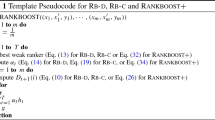Abstract
In this paper, we propose a novel learning to rank method using Ensemble Ranking SVM. Ensemble Ranking SVM is based on Ranking SVM which has been commonly used for learning to rank. The basic idea of Ranking SVM is to formulate the problem of learning to rank as that of binary classification on instance pairs. In Ranking SVM, the training time of generating a train model grows exponentially as the training data set increases in size. To solve this problem and improve the ranking accuracy, we introduce ensemble learning into Ranking SVM. Therefore, Ensemble Ranking SVM remarkably improves the efficiency of the model training as well as achieves high ranking accuracy. Experimental results demonstrate that the performance of Ensemble Ranking SVM is quite impressive from the viewpoints of ranking accuracy and training time.



Similar content being viewed by others
References
Qin T, Liu TY, Xu J, Li H (2010) LETOR: a benchmark collection for research on learning to rank for information retrieval. Inf Retr 13:346–374
Qin T, Liu TY, Lai W, Zhang XD, Wang DS, Li H (2007) Ranking with multiple hyperplanes. In Proceedings of the 30th annual international ACM SIGIR conference on research and development in information retrieval, pp 279–286
Cao Y, Xu J, Liu TY, Li H, Huang Y, Hon HW (2006) Adapting ranking svm to document retrieval. In: Proceedings of the 29th annual international ACM SIGIR Conference on research and development in information retrieval, pp 186–193
Xu J, Cao Y, Li H, Huang Y (2006) Cost-sensitive learning of SVM for ranking. In: Proceedings of ECML, pp 833–840
Harrington EF (2003) Online ranking/collaborative filtering using the perceptron algorithm. In: Proceedings of the 20th international conference on machine learning, pp 250–257
Gyöngyi Z, Garcia-Molina H, Pedersen J (2004) Combating web spam with trustrank. In Proceedings of the 30th international conference on very large data bases, pp 576–587
Radev DR, Jing H, Sty M, Tam D (2004) Centroid-based summarization of multiple documents. Inf Process Manag 40:919–938
Cao Z, Qin T, Liu TY, Tsai MF, Li H (2007) Learning to rank: from pairwise approach to listwise approach. In: Proceedings of the 24th international conference on machine learning, pp 129–136
Herbrich R, Graepel T, Obermayer K (1999) Support vector learning for ordinal regression. In: Proceedings of ICANN 1999, pp 97–102
Freund Y, Iyer R, Schapire RE, Singer Y (1998) An efficient boosting algorithm for combining preferences. In: Proceedings of the 15th international conference on machine learning, pp 170–178
He C, Wang C, Zhong YX, Li RF (2008) A survey on learning to rank. In: Proceedings of the 25th international conference on machine learning, pp 12–15
Dietterich TG (2000) Ensemble methods in machine learning. In: Proceedings of MCS 2000, pp 1–15
Valentini G, Masulli F (2002) Ensembles in learning machines. In: Proceedings of the 13th Italian workshop on neural nets, pp 3–20
Xu J, Li H (2007) Adarank: a boosting algorithm for information retrieval. In: Proceedings of the 30th annual international ACM SIGIR conference on research and development in information retrieval, pp 391–398
Sun Z, Qin T, Tao Q, Wang J (2009) Robust sparse rank learning for non-smooth ranking measures. In: Proceedings of the 32nd international ACM SIGIR conference on research and development in information retrieval. pp 259–266
Burges C, Shaked T, Renshaw E, Lazier A, Deeds M, Hamilton N, Hullender G (2005) Learning to rank using gradient descent. In: Proceedings of the 22nd international conference on machine learning, pp 89–96
Vapnik V (1998) Statistical learning theory. Wiley, New York
Turpin A, Scholer F (2006) User performance versus precision measures for simple search tasks. In: Proceedings of the 29th annual international ACM SIGIR Conference on research and development in information retrieval, pp 11–18
Jarvelin K, Kekalainen J (2002) Cumulated gain-based evaluation of IR techniques. ACM Trans Inf Syst 20(4):422–446
Joachims T (2002) Optimizing searching engines using click-through data. In: Proceedings of the ACM conference on knowledge discovery and data mining, pp 133–142
Microsoft Research Asia (2008) Letor 3.0: benchmark datasets for learning to rank. Microsoft Corporation
Nallapati R (2004) Discriminative models for information retrieval. In: Proceedings of the 27th annual international ACM SIGIR conference on research and development in information retrieval, pp 64–71
Joachims T (1999) Making large-scale SVM learning practical. In: Schölkopf B, Burges C, Smola A (eds) Advances in kernel methods—support vector learning. MIT Press, Cambridge, MA
Polikar R (2006) Ensemble based systems in decision making. IEEE Circuits Syst Mag 6(3):21–45
Jung C, Jiao L, Shen YB (2011) Ensemble ranking SVM for learning to rank. In: Proceedings of IEEE MLSP
Acknowledgments
An initial version of this paper appeared in 2011 IEEE International Workshop on Machine Learning for Signal Processing (MLSP 2011) [25]. The authors would like to thank the anonymous reviewers for their valuable comments that have led to improvements in the quality and presentation of the paper. This work was supported by the National Natural Science Foundation of China (No. 61271298) and the International S&T Cooperation Program of China (No. 2014DFG12780).
Author information
Authors and Affiliations
Corresponding author
Rights and permissions
About this article
Cite this article
Jung, C., Shen, Y. & Jiao, L. Learning to Rank with Ensemble Ranking SVM. Neural Process Lett 42, 703–714 (2015). https://doi.org/10.1007/s11063-014-9382-5
Published:
Issue Date:
DOI: https://doi.org/10.1007/s11063-014-9382-5




